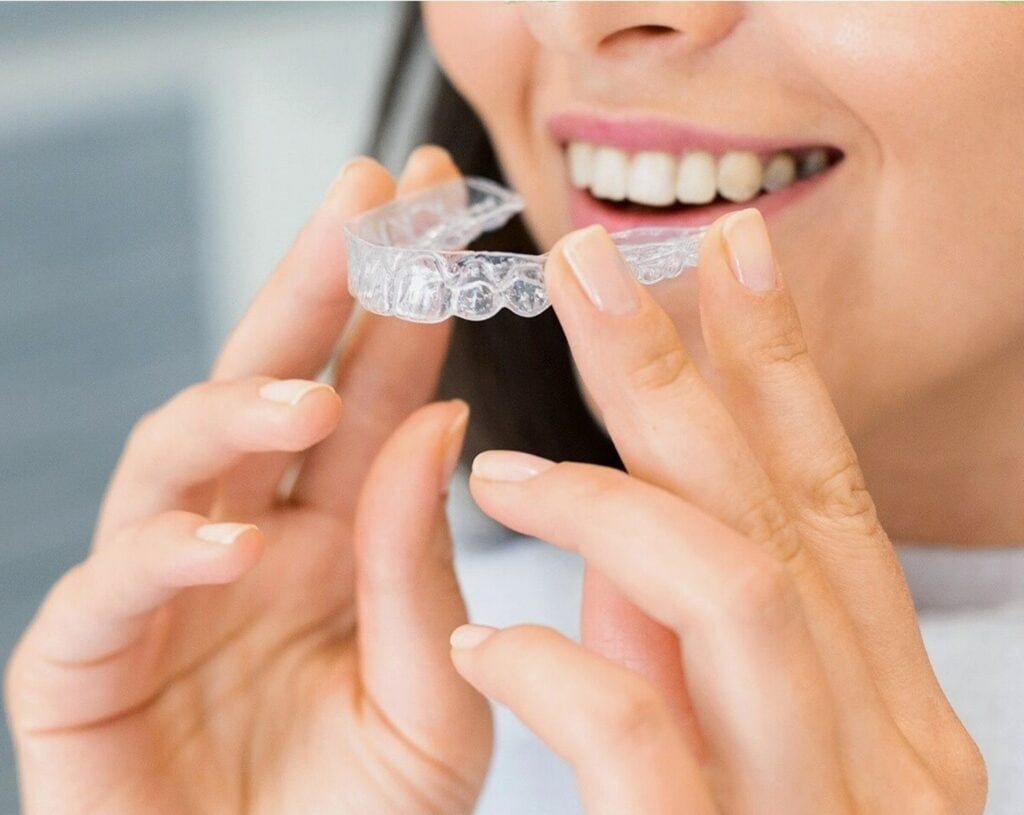Can Invisalign Fix Gaps? How Clear Aligners Close Spaces Between Teeth
Gaps between teeth can be a significant concern for many individuals, not just for aesthetic reasons but also for oral health. Can Invisalign fix gaps between your teeth?
Yes it can! Clear aligners like Invisalign are gaining popularity in Colorado for their effectiveness in closing gaps and enhancing smiles with less invasiveness compared to other kinds of orthodontic treatment.
In this blog post, we’ll explore how Invisalign can correct gaps between teeth, the mechanics behind treatment, and the various factors that influence the duration of treatment.
Read next: How much does Invisalign cost?

What Causes Gaps Between Teeth?
Before diving into how Invisalign can help, it’s essential to understand what causes gaps, known as diastema, between teeth. Various factors contribute to these spaces:
- Genetics: Some individuals inherit larger jawbones compared to the size of their teeth, leading to spacing issues.
- Habits: Childhood habits such as thumb sucking can push teeth out of alignment.
- Missing Teeth: When a tooth is lost due to injury or decay, adjacent teeth may drift into the gap, creating more misalignment.
- Gum Disease: Conditions affecting the gums can lead to teeth shifting and create gaps.
How Invisalign Works to Close Gaps
Invisalign utilizes a series of clear, custom-made aligners designed to move teeth gradually into the desired position. Each aligner is crafted for a specific stage in your treatment, ensuring precision and comfort. The process begins with an initial consultation, where your orthodontist assesses your needs and creates a detailed treatment plan using advanced 3D imaging technology.
Once your aligners are created, you’ll wear each set for about two weeks. As you transition to the next aligner, gentle pressure is applied to shift your teeth little by little. This discreet method allows you to close gaps effectively while maintaining your confidence throughout the treatment.
Read next: Understanding How Invisalign Moves Teeth
The Mechanics of Tooth Movement
Understanding the mechanics behind how Invisalign moves teeth is crucial. There are three orders of tooth movement: translation, tipping, and torque.
- Translation: This involves moving the entire tooth in the same direction (horizontal movement).
- Tipping: This refers to the tilting of the tooth around its center of resistance (side to side tipping).
- Torque: This deals with the movement of the tooth in a buccal-lingual direction (front to back).
Invisalign primarily works through tipping and translation. For effective movement, it’s crucial to apply force correctly. Think of it as pushing a car down a hill; you need to ensure there’s control over the direction of movement.
Determining Treatment Duration
One common question is, “How long does it take to treat gaps with Invisalign?” The duration of treatment can vary based on several factors:
- Severity of Gaps: Larger gaps may require more aligners and thus a longer treatment time. Each aligner can only shift teeth a certain amount before switching to a new aligner is needed.
- Initial Position of Teeth: If the teeth are already in a favorable position, treatment may be quicker.
- Patient Compliance: Wearing aligners for 20-22 hours a day is essential for timely progress.
- Regular Check-Ups: Consistent appointments with your orthodontist to monitor progress can also affect duration.
As a rule of thumb, Invisalign can move teeth approximately 1-2 degrees per aligner. Therefore, if a significant rotation or movement is needed—say, 30 degrees—you might expect to need around 15 aligners. However, this is just a guideline; individual experiences may vary.

After the First Series of Aligners
Once you complete the first set of aligners, it’s essential to assess the progress. For instance, if a patient wore 20 aligners and achieved substantial improvement, they might still need additional aligners for fine-tuning. The goal is always to achieve the best possible result, and sometimes that means extending treatment slightly.
Final Thoughts on Closing Gaps with Invisalign
Invisalign presents a modern and effective solution for closing gaps between teeth. It combines technology, precision, and comfort, making it an appealing choice for many patients.
By understanding the mechanics of tooth movement and the importance of attachments, patients can better appreciate how Invisalign works to achieve their desired smile.
If you’re considering Invisalign for correcting gaps in your teeth, consult with a qualified orthodontist to explore your options. With the right approach and commitment, you can enjoy a beautiful, gap-free smile.
Frequently Asked Questions (FAQs)
1. Can Invisalign fix gaps in teeth permanently?
Yes, Invisalign can effectively close gaps between teeth permanently, provided that you maintain your retainer use after treatment to prevent relapse.
2. How long does treatment usually take?
Treatment duration varies, but on average, it can take anywhere from 6 months to 18 months, depending on the severity of the gaps and patient consistency in wearing aligners.
3. Are the aligners comfortable to wear?
Most patients find Invisalign aligners comfortable. They are made of smooth plastic, which reduces irritation compared to traditional metal braces.
4. Can I eat and drink with Invisalign on?
You should remove your aligners while eating and drinking to maintain hygiene and avoid damaging the aligners.
5. What happens if I don’t wear my aligners for the recommended time?
Not wearing your aligners for the recommended 20-22 hours can delay your treatment progress and may lead to suboptimal results.
In conclusion, if you’re looking to close gaps between your teeth, Invisalign offers a discreet, effective, and comfortable solution. Consult with your orthodontist to see if you’re a candidate for this innovative treatment.